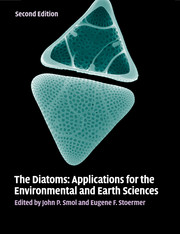Book contents
- Frontmatter
- Contents
- List of contributors
- Preface
- Part I Introduction
- Part II Diatoms as indicators of environmental change in flowing waters and lakes
- Part III Diatoms as indicators in Arctic, Antarctic, and alpine lacustrine environments
- Part IV Diatoms as indicators in marine and estuarine environments
- Part V Other applications
- 24 Diatoms of aerial habitats
- 25 Diatoms as indicators of environmental change in wetlands and peatlands
- 26 Tracking fish, seabirds, and wildlife population dynamics with diatoms and other limnological indicators
- 27 Diatoms and archeology
- 28 Diatoms in oil and gas exploration
- 29 Forensic science and diatoms
- 30 Toxic marine diatoms
- 31 Diatoms as markers of atmospheric transport
- 32 Diatoms as non-native species
- 33 Diatomite
- 34 Stable isotopes from diatom silica
- 35 Diatoms and nanotechnology: early history and imagined future as seen through patents
- Part VI Conclusions
- Glossary, acronyms, and abbreviations
- Index
- References
28 - Diatoms in oil and gas exploration
from Part V - Other applications
Published online by Cambridge University Press: 05 June 2012
- Frontmatter
- Contents
- List of contributors
- Preface
- Part I Introduction
- Part II Diatoms as indicators of environmental change in flowing waters and lakes
- Part III Diatoms as indicators in Arctic, Antarctic, and alpine lacustrine environments
- Part IV Diatoms as indicators in marine and estuarine environments
- Part V Other applications
- 24 Diatoms of aerial habitats
- 25 Diatoms as indicators of environmental change in wetlands and peatlands
- 26 Tracking fish, seabirds, and wildlife population dynamics with diatoms and other limnological indicators
- 27 Diatoms and archeology
- 28 Diatoms in oil and gas exploration
- 29 Forensic science and diatoms
- 30 Toxic marine diatoms
- 31 Diatoms as markers of atmospheric transport
- 32 Diatoms as non-native species
- 33 Diatomite
- 34 Stable isotopes from diatom silica
- 35 Diatoms and nanotechnology: early history and imagined future as seen through patents
- Part VI Conclusions
- Glossary, acronyms, and abbreviations
- Index
- References
Summary
Introduction
Diatoms constitute an important rock-forming microfossil group. They evolved rapidly during the Cenozoic, and unlike other microfossils, diatoms are found in marine, brackish, and lacustrine sediments, and are thus useful for age dating and correlating sediments that accumulated in a variety of environments. Their fossil assemblages are reflective of the environments in which they lived, and their recovery in wells and outcrops can provide information on paleochemistry and paleobathymetry. They are most useful to the oil and gas industry in age dating and correlating rocks that lack or have poor recovery of calcareous microfossils, such as “cold-water” Tertiary marine rocks, and sediments that accumulated in lacustrine basins and in brackish-water settings.
Age dating and correlation of sedimentary rocks are important for hydrocarbon exploration in order to understand the geologic history of a basin as it relates to formation of source rocks, reservoirs, structures, and seals. The timing of expulsion of oil and gas is a critical factor in determining the prospect potential of a basin for hydrocarbon, and necessitates an understanding of the geochronology of events. The ability to correlate subsurface rocks is a prerequisite to mapping the distribution of reservoir facies and the interpretation of sequence stratigraphy.
Environmental data pertaining to paleobathymetry and paleochemistry provide important information on the geologic history of a basin and predictability of reservoir distribution. For example, shales that are barren of calcareous microfossils may have accumulated in deep water, beneath the carbonate compensation depth, or in brackish or freshwater.
- Type
- Chapter
- Information
- The DiatomsApplications for the Environmental and Earth Sciences, pp. 523 - 533Publisher: Cambridge University PressPrint publication year: 2010
References
- 5
- Cited by



